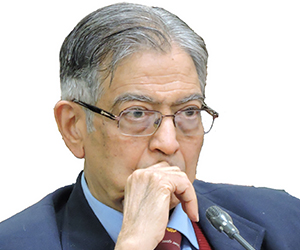The first India-Bangladesh Joint Consultative Commission meeting held at the minister level on May 7 and at the foreign secretary level on July 24 are a convenient inflexion point to assess the trend of ties between both countries. Regrettably, neither received the attention they deserved from the media that remains fixated on the sterile and unproductive India-Pakistan relationship.
With Sheikh Hasina’s assumption of power in January 2009, her path-breaking visit to India in February 2010, and Manmohan Singh’s visit to Bangladesh in September 2011, India-Bangladesh relations have been on an upturn. This qualitative improvement in ties is largely been due to the Awami League government’s readiness to meet India’s security concerns without seeking any quid pro quo, its secular outlook, and an openness to explore wide ranging cooperation with India. The latter deeply appreciative of Bangladesh’s positivity has reciprocated with several moves such as the accord of a $1billion credit, grant of duty free entry of Bangladeshi goods to India barring a small negative list of 25 items, provision of transit to Nepal and Bhutan, etc.
Clearly India-Bangladesh relations are in a transformative phase, the template for which is reflected in the Framework Agreement on Cooperation for Development signed by the prime ministers of the two countries in September 2011. The cooperative activities specified in this agreement extend to virtually every conceivable area ranging from economic and commercial field to security, from connectivity to management of water resources and from energy to cultural exchanges.
In order to ensure the actualisation of the aforesaid cooperative activities a Joint Consultative Commission has been set up at foreign minister level to oversee their progression. This mechanism is backed by annual consultations at the foreign secretary level and biannual consultations at the joint secretary level.
In concrete terms the following are some of the positive developments in the last several months: conclusion of the protocol on the land boundary which by creating a clearly demarcated and undisputed 4,096-km border will facilitate its policing and thereby vastly enhance national security; grant of 24-hour access to Bangladeshi nationals to Dahagram and Angarpota enclaves through Tin Bigha; opening of border haats on Bangladesh’s borders with Tripura and Meghalaya; implementation of a Coordinated Border Management Plan to control cross-border illegal activities and crimes and maintenance of peace and harmony; under the $1 billion line of credit offered to Bangladesh by India, the latter has already cleared contracts/ projects worth about $800 million. It has reduced the interest rate from 1.75 per cent to 1 per cent and converted 20 per cent of the credit into a grant; India’s trade liberalisation measures for Bangladeshi goods have already resulted in a 60 per cent increase in Bangladesh exports to India in the period July-June 2010-11 as compared to the level a year ago; an agreement has been concluded for purchase of 250 MW of power by Bangladesh from India and purchase of another 250 MW is likely. Intergrid connectivity is expected to be established between the two countries by 2013. A joint venture for setting up a 1,350 MW thermal plant in Bangladesh has also been established, and; India has assured Bangladesh that it would not take any unilateral decision on the Himalayan segment of its river linking project that may affect Bangladesh, and that a sub-group of the India-Bangladesh Joint Rivers Commission would visit Tipaimukh to go into all aspects of the hydroelectric project being set up there.
India can be faulted for having failed to deliver on two issues on which Bangladesh sets great store, due to Mamata Banerjee’s opposition, namely sharing of Teesta waters and implementation of the protocol for settlement of the land boundary. On Teesta, the agreement negotiated with Bangladesh is eminently reasonable and, in fact, had only been finalised after keeping West Bengal in the loop. It envisages an equitable sharing of the Teesta waters at the point of entry into Bangladesh after providing for about 500 cusecs of water to inter alia maintain the flow of the river. The agreement set to be signed during Manmohan Singh’s visit to Bangladesh in September 2011was postponed due to Mamata’s last minute objections. Since water is a highly emotive issue in Bangladesh our reneging in this matter took the sheen of Manmohan Singh’s visit and exposed Sheikh Hasina to severe criticism at home. As the Bangladesh foreign minister pointed out whilst recently in India, relations between the two countries “will take a huge hit” if India does not deliver on Teesta. In practical terms, this has induced Bangladesh to go slow on several connectivity-related issues that are of great importance to us.
The Protocol on the Land Boundary Agreement so meticulously negotiated, after taking into account the wishes of the affected peoples, will result in a fixed demarcated boundary, entail the exchange of 111 Indian enclaves in Bangladesh with an area of 17,160 acres and 51 Bangladeshi enclaves in India with an area of 7,110 acres, and retention by each country of the areas held by it in adverse possession. (2,777 acres by India and 2,267 by Bangladesh). Implementation of the protocol apart from being in the mutual security interest and helping promote a harmonious environment on the borders, will enable the local residents for the first time to enjoy full legal rights as citizens of India or Bangladesh with proper civic facilities. It is no surprise, therefore, that these people are pressing for urgent implementation of the protocol. Arguments to the effect that as a result of the protocol India would lose more land or that it would cause a major influx of people into the country are untenable. For one thing, the amount of land and people involved is paltry, particularly as compared to the benefits accruing from the proposed settlement. Moreover, transfer of land is only notional as neither country exercised effective control on its enclaves in the other country. Movement of people will also be negligible as most will stay where they are and assume the nationality of the country where they reside.
In order to fast track the improvement in India-Bangladesh ties and, indeed, make it irreversible, the government must urgently override Mamata’s irrational objections to the settlement of the Teesta and boundary issues. Speedy delivery by us on these two issues will also help in consolidating the Awami League’s position that would obviously be in our interest, particularly given the inimical bias of the BNP and Jamaat against India.
Published Date: 10th August 2012










Post new comment